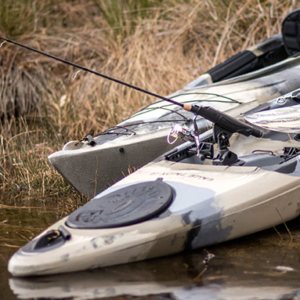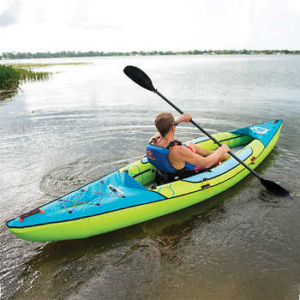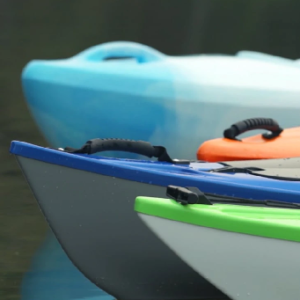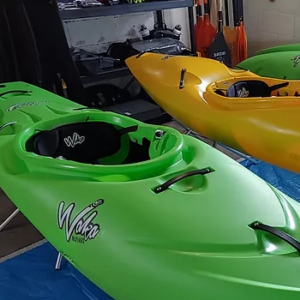A Few Things To Consider When Buying A New Kayak!
It can be a very exciting time preparing for the purchase of your first kayak. This excitement will tend to include plenty of daydreaming about all of the fun you will have. Your new kayak can supply endless hours of enjoyment paddling around in the great outdoors. Before you make your kayak purchase and hit your favorite spot on the water, there are some things that you need to think about. These are 5 things to consider when buying your first kayak.
Which Kayak Category Do You Prefer? (Sit-In or Sit-on-Top)
The first thing to consider when you are buying your first kayak is whether you want a sit-in or sit-on-top model. Both of these options have their own compelling benefits. Your choice will really depend on exactly what you are looking for in your kayaking experience.

Sit In Kayaks
Sit-in kayaks have an opening you slide into so you will end up sitting inside of the hull. Their benefits include added shelter from the water and wind. Since you are inside the kayak you expose less of your body to the elements.
Sit-in kayaks also tend to have more storage space. Because you have access to the entire inside of the kayak, you can use that access to store more equipment. The sit-in kayak variety also tends to be more efficient from a paddling standpoint. This is due to a lower center of gravity.
The downside to these type of kayaks is the difficulty of getting in and out. Lowering your body down into the kayak then attaching a spray skirt around you can a bit cumbersome. If you happen to flip your kayak, more serious issues can arise as the kayak will likely fill with water.
Sit On Top Kayak
The benefits of the sit-on-top kayak include their versatility. This makes them a good option for beginners. They are easy to get on and off because you are sitting on top. Simply put the kayak in the water and hop on.
A great feature of sit on top kayaks is the fact they are self-bailing. There are small holes in the kayak called ‘scuppers’. These allow any water that splash over the top of the kayaks to simply flow down the supper holes back into the lake or ocean.
Sit-on-top kayaks are also great for warm water environments because you are likely to get splashed. Although this might be fun on a summer day on your Hawaii vacation, it might not be what you want on a colder day out fishing. So one of the down sides of the ‘sit on top’ vs the ‘sit in’ is the fact that you will likely get wet as you are more exposed to water splashing and rolling over the top of the kayak.
Choosing the Right Kayak for Your Experience Level
It is important to consider your experience level when purchasing your kayak. This involves deciding between a beginner, intermediate, or advanced model.
Beginner – Recreational Kayaks
Beginner models are commonly referred to as recreational kayaks. They usually have larger cockpits which makes them easier to get in and out of. Sit-on-top kayaks are considered by some to be a beginner’s model because they are so easy to work with and learn how to use.
Beginner kayaks will usually be between 6-12 ft in length. Shorter length kayaks are easier to maneuver making it easy to make quick turns. They are also a little wider than other types which make them more stable and less likely to tip over. The draw back to all this is that a wider, shorter kayak requires more effort to paddle through the water. You can find the most popular beginner kayaks here > recreational kayaks

Advanced – Touring Kayaks
Advanced kayaks, also referred to as touring-style kayaks are designed for the more advanced kayakers that go on longer distance kayak trips. They are made out of thinner materials and are usually longer than entry level kayaks which makes them faster and easier to paddle. These kayaks are suitable for more challenging water situations and longer distances than their beginner counterparts.
The main drawback of this style of kayak is portability. These kayaks are hard to carry and transport on your vehicle due to the length. Some may be up to 16ft or more in length. The width of touring kayaks are more narrow to help them ‘cut’ through the water more easily. This means the kayak can be less stable thus requiring more skill from the paddler.

Intermediate Kayaks
There are more and more intermediate models on today’s kayak market that exists somewhere between the beginner and advanced options. They tend to have larger cockpits similar to beginner models but are made from thinner material in the manner of an advanced kayak. They are also a bit longer to make paddling longer distances a bit easier. Many fishing kayaks fall into this category. Fishing kayaks need to be stable but relatively quick on the water. There is a need for ease of use and access thus sit-on-top are the more popular type for this activity. They also require modest amounts of storage space. So if you are looking for a good intermediate kayak, consider a fishing kayak for your purchase.
What Is The Best Kayak Material?
Several common material types are used in the manufacture of today’s kayaks. The majority of kayaks are made from plastic due to its durability and the fact that it is easier to repair. Other material types include fiberglass. This option is more costly to purchase and is also easier to damage/more expensive to repair. Regardless it is preferred by some kayakers because of the fact that it is lightweight.
Inflatable Kayaks
I don’t want to leave out mentioning the ever growing popularity of the inflatable kayak. Many who are considering this type of kayak as opposed to a hard-shell are doing so for two reasons. One reason is that storage and transporting is much easier with an inflatable. Second, inflatable kayaks can be much cheaper. So for these reasons inflatable kayaks might be the most accessible way to get out on the water.
There is a lot to consider when deciding on purchasing an inflatable kayak. One of the biggest things to consider is the material your kayak is made of. There are basically two general types of inflatable materials. One is for low impact, recreational use the other for more rugged activities of longer duration and distance.
Cheap inflatable kayaks can be enticing as they are often under $250. The major drawback is the material these are constructed with. Generally these are made with some type of vinyl material, like what you get with a blow-up mattress. There are different versions of this material but bottom line, its not very puncture resistant and any seams are prone to leak after a short life span. If all you plan to do is take your kayak up to the lake for short paddles along the shore or other basic recreational activities in good weather, this can be a great choice.
If you are looking for an inflatable that can take you out into the ocean or travel a few miles into the back waters of a large lake or river, you need an inflatable kayak that is constructed of durable and strong materials. Kayaks of this sort are going to be constructed of a rubber or PVC material. You also want a kayak that has multiple chambers so if one is compromised, you will still float and be able to get back to the launch. Generally these materials will have a long life of 15 years or more, if cared for properly.
Of course you can’t get all these good things without a price. And that could be exactly the problem, a premium price tag that can get up to $1000 or more. Of course many good hard-shell kayaks are the same price or higher. So if transportation or storage keep you from having a traditional kayak, the inflatable may be just the thing. Be sure to carefully consider your needs, and get the inflatable that will be the best and safest for your needs.
How Much Storage Is Needed In A Kayak?
Storage is another factor to consider when making a final decision on the purchase of your first kayak. You want to make sure that the model you purchase has sufficient in-kayak storage for the types of adventures that you will be taking it on. The last thing you want is your expensive gear falling overboard or getting wet.
Sit in kayaks can offer a lot of storage as the majority of the inner portion of the kayak is accessible to the kayaker. Sit on top kayaks often only have access to small sections of the inner hull through a 6 or 8 inch hatch opening. So often items will need to be ‘lashed down’ on top of the kayak, as there may not be room to get it inside. This is often an acceptable alternative but you may need to consider purchasing ‘dry bags’ to keep your stuff from getting wet.
If you plan to do a lot of long distance kayaking with camping equipment and other items you will want to think carefully about which kayak can fulfil your needs. If you plan on only doing short trips, or activities that do not require lots of cargo then focus on portability and easy of use.






